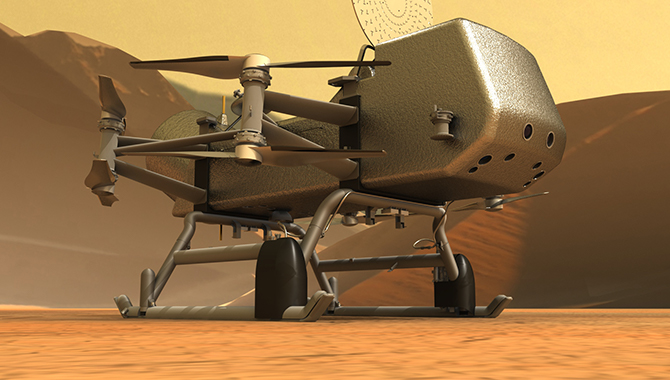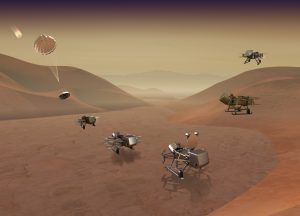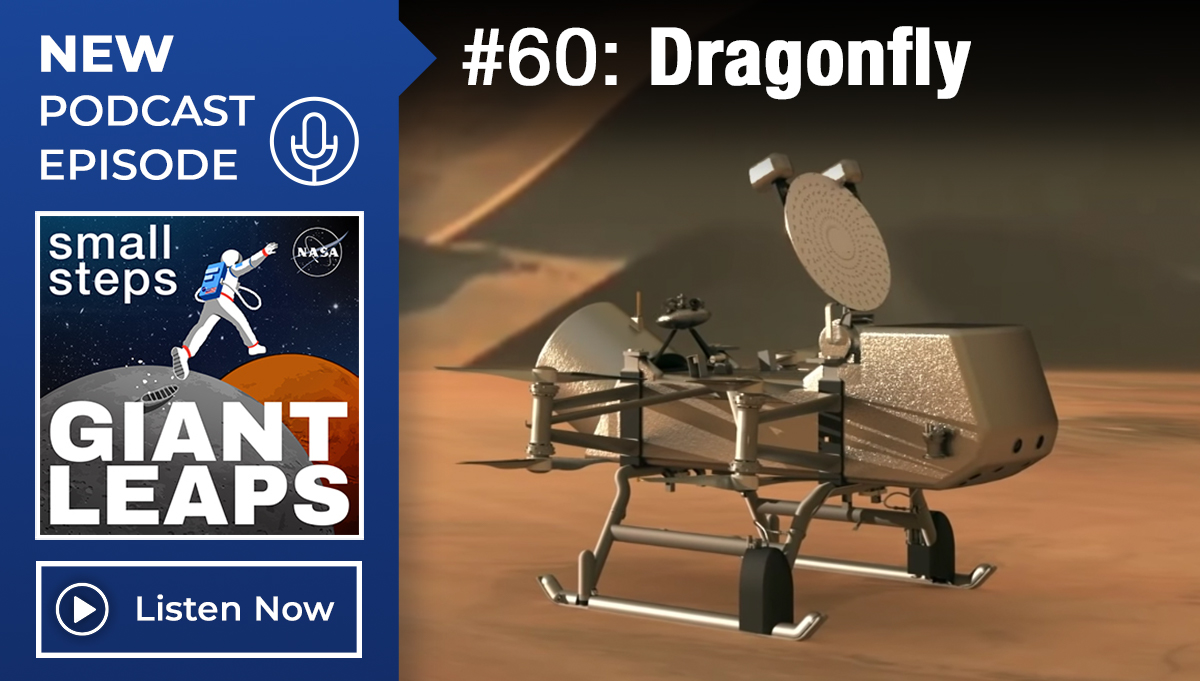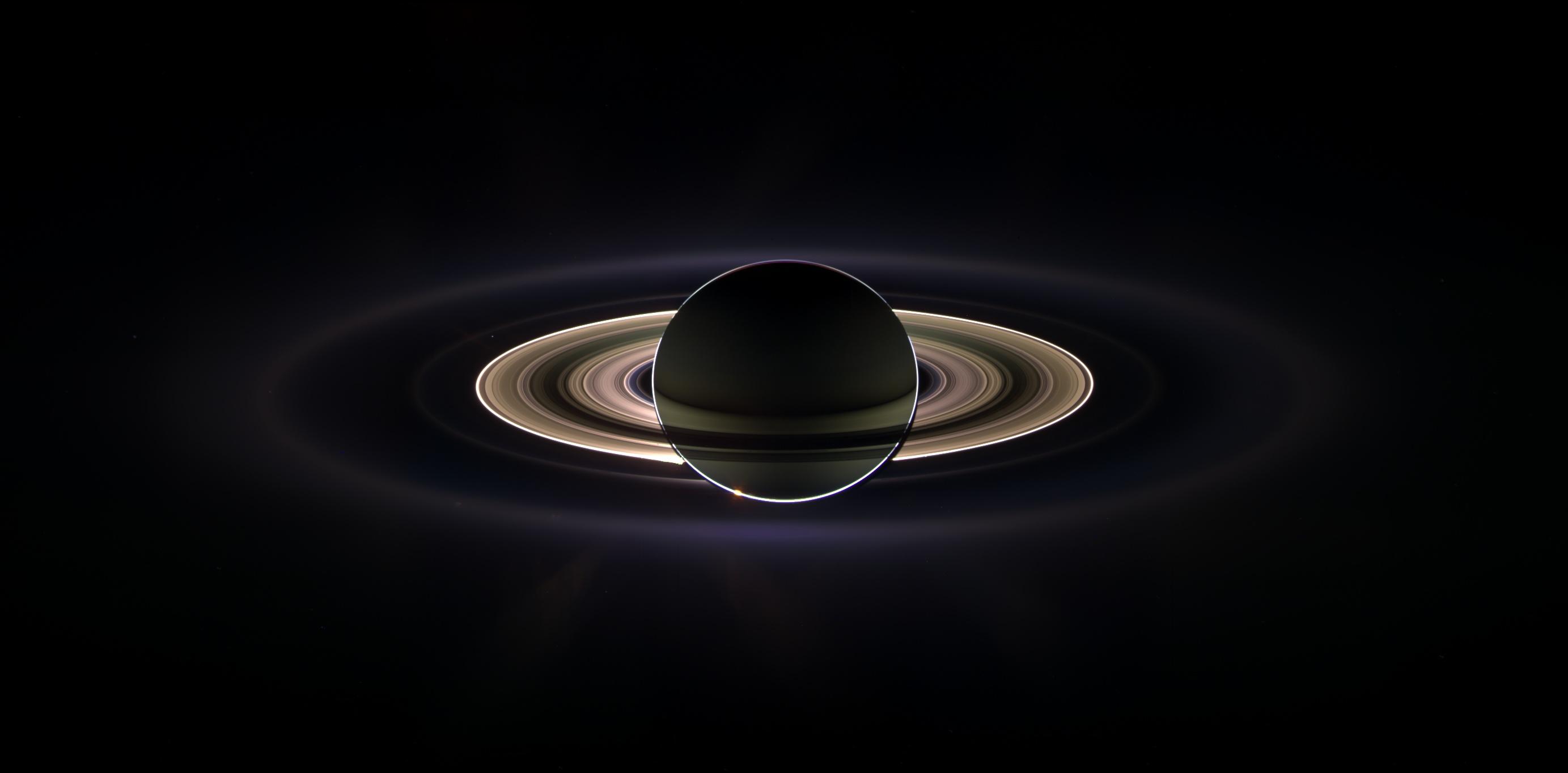
Illustration of NASA’s Dragonfly rotorcraft-lander on the surface of Titan.
Credit: Johns Hopkins APL
Saturn’s largest moon holds vast oceans, organic chemistry.
On January 14, 2005, a spacecraft about 9 feet wide, with a mass of about 700 pounds entered the atmosphere of Titan, Saturn’s largest moon. Over the next two and a half hours, the Huygens probe, as the spacecraft was known, would report data from its descent through the thick atmosphere of Titan to the orbiting Cassini spacecraft above, and back to Earth. It also returned an image and data from the surface.
A generation of scientific discoveries was contained in the Cassini mission data, leading to the publication of more than 4,000 scholarly papers. Cassini’s flybys of Titan, coupled with data from the Huygens probe, yielded tantalizing clues of a world in which complex organic compounds form beneath methane clouds in a nitrogen-rich atmosphere, over a global subsurface ocean covered by a thick layer of water ice, and rivers of methane.
This means that Titan, in essence, is an ocean world laboratory that has been doing organic chemistry for hundreds of millions of years, according to Elizabeth “Zibi” Turtle, a planetary scientist at the Johns Hopkins University Applied Physics Laboratory (APL).
“We know that Titan has all the key ingredients necessary for the development of life. It has energy—in the form of sunlight—that drives photochemistry in the atmosphere. It has abundant complex organics because of this chemistry in the atmosphere and interactions of the surface. And then, it has liquid—but it has two kinds of solvents. So not only are there liquid hydrocarbons on the surface, which could act as solvents, in an alternative, exotic biological system, but there will also have been liquid water present on the surface in the past, and there is liquid water in the interior ocean,” said Turtle, in an APL video.
Turtle is the Principal Investigator on a new project—Dragonfly—planned to land on the surface of Titan in 2034, 29 years after the Huygens probe did, and explore the moon for a primary mission of 2.7 years. Dragonfly will be an eight-bladed autonomous rotorcraft-lander that will arrive within a protective aeroshell and deploy a parachute to reach the Titan surface safely.

Dragonfly mission concept of entry, descent, landing, surface operations, and flight at Titan. Credit: Johns Hopkins APL
Dragonfly will be about 10 feet long and 10 feet wide. It is scheduled to arrive approximately one Titan year after the Huygens probe did, and land at a similar latitude. This maximizes the likelihood that atmospheric conditions for Dragonfly’s landing will be similar to those in the Huygens data.
Dragonfly will carry a full suite of scientific instruments, including a mass spectrometer for very detailed measurements of the surface composition, a gamma ray and neutron spectrometer for measuring bulk elemental surface composition, a suite of instruments to monitor atmospheric pressure, temperature, and wind, and a suite of cameras to take images and help the team gather advanced visual evidence of future landing sites.
The project takes advantage of the staggering advances in drone and autonomous flight technology over the past two decades to dramatically expand the range of the mission beyond that of traditional rovers. Plans call for Dragonfly to cover more than 100 miles on the surface of Titan. The team will use a “leapfrog” approach to sites, flying over a future potential site for recognizance while on the way to the next site.
Titan is the second largest moon in our solar system, orbiting Saturn at about 886 million miles from the Sun. Compared to Earth, Titan’s atmosphere is about four times denser and its gravity much weaker—about 1/7th as strong. Dragonfly must be able to function in Titan’s harsh atmosphere and extreme cold—minus 290 degrees Fahrenheit at the surface.
“Flight is easier on Titan than Earth,” Turtle said. “Because of [the] atmosphere’s density and the low gravity, heavier than air mobility is very efficient. … Dragonfly also leverages decades of autonomous drone experience and well-understood flight dynamics on Earth — and applies them in a whole new environment.”
Titan intrigues scientists, who view it as an opportunity to examine an exotic world that holds many of the building blocks for life and in which prebiotic chemistry is occurring. Dragonfly’s findings might provide clues as to how the early Earth moved from chemistry to biology.
Dragonfly will be managed by APL, working with NASA and its partners, as part of NASA’s New Frontiers Program, which focuses on exploring the solar system through high-science-return investigations.








